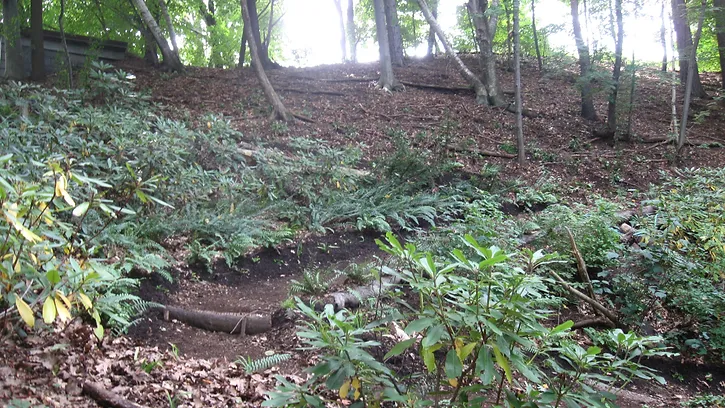Native plants were directly planted into the FilterMitts™ so as to mimic natural trees fallen upon the forest floor inhabited by ferns and herbaceous wildflower seedlings growing on them. John re-used natural materials that he found lying around the cemetery grounds and placed the dead trees, branches and stumps into the landscape to create water diversion devices and to stabilize the sloping soils. Then, he, combined them with EarthBlanket™ and FilterMitts™ products that are manufactured, trademarked and patented by Groundscapes Express, Inc. to create a more natural solution to sediment prevention and stormwater management.
These materials are made from aerobic thermophytic composted vegetative waste, which are by products of land clearing, tree management, garden plant trimmings, municipal leaf removal, and industrial vegetative waste materials that all have been diverted from taking up valuable space in our public landfills. The EarthBlanket™ and FilterMitt™ meet USEPA standards for sediment prevention and for stormwater management. More of the EarthBlanket™ was blown in place using a pneumatic blower, a Groundscapes Express. Inc., adaptation for delivering their composted materials to remote sites by the employment of hose lengths up to 300 feet from the equipment to provide a low impact solution helping to hold in the FilterMitts™ in place and to absorb some of the stormwater runoff, while also providing a soil amendment, a mulch and a planting medium for the herbaceous perennial plant seedlings.
Groundscapes Express, Inc. removed many of the existing woody shrubbery and integrated live herbaceous perennial plant and grass seedlings as part of the solution to provide a readily established functional plant community that could easily adapt to the environmental conditions of the cemetery. This plant community would also stabilize the sloping soils, retain the moving rainwater in their roots and in the soil, help in building top soil by increasing the below ground microbial communities as well as the above ground biodiversity, capturing carbon from the atmosphere and using it for cell development and energy and storing it in the soils. This additions of beautiful color to the landscape, when flowering occurs, also add to the life cycles of beneficial insects and pollinator species. The health of the whole living landscape at Mount Auburn is improved including mutualistic bird species, thus creating a vibrant, dynamic, and visually pleasing landscaped environment to enjoy!


